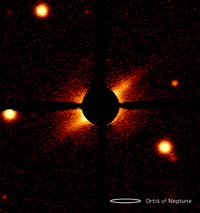UC Berkeley Press Release
Astronomers find nearest and youngest star with a dusty debris disk. But are there planets?
BERKELEY – Astronomers at the University of California, Berkeley, have discovered the nearest and youngest star with a visible disk of dust that may be a nursery for planets.
The dim red dwarf star is a mere 33 light years away, close enough that the Hubble Space Telescope or ground-based telescopes with adaptive optics to sharpen the image should be able to see whether the dust disk contains clumps of matter that might turn into planets.
"Circumstellar disks are signposts for planet formation, and this is the nearest and youngest star where we directly observe light reflected from the dust produced by extrasolar comets and asteroids - i.e., the objects that could possibly form planets by accretion," said Paul Kalas, assistant research astronomer at UC Berkeley and lead author of a paper reporting the discovery.
"We're waiting for the summer and fall observing season to go back to the telescopes and study the properties of the disk in greater detail. But we expect everyone else to do the same thing - there will be lots of follow-up."
A paper announcing the discovery will be published online in Science Express this week, and will appear in the printed edition of the journal in March. Coauthors with Kalas are Brenda C. Matthews, a post-doctoral researcher with UC Berkeley's Radio Astronomy Laboratory, and astronomer Michael C. Liu of the University of Hawaii. Kalas also is affiliated with the Center for Adaptive Optics at UC Santa Cruz.
The young M-type star, AU Microscopium (AU Mic), is about half the mass of the sun but only about 12 million years old, compared to the 4.6 billion year age of the sun. The team of astronomers found the star while searching for dust disks around stars emitting more than expected amounts of infrared radiation, indicative of a warm, glowing dust cloud.
The image of AU Mic, obtained last October with the University of Hawaii's 2.2-meter telescope atop Mauna Kea, shows an edge-on disk of dust stretching about 210 astronomical units from the central star - about seven times farther from the star than Neptune is from the sun. One astronomical unit, or AU, is the average distance from the Earth to the sun, about 93 million miles.
"When we see scattered infrared light around a star, the inference is that this is caused by dust grains replenished by comets and asteroid collisions," Kalas said. Because 85 percent of all stars are M-type red dwarfs, the star provides clues to how the majority of planetary systems form and evolve.
Other nearby stars, such as Gliese 876 at 16 light years and epsilon-Eridani at 10 light years, wobble, providing indirect evidence for planets. But images of debris disks around stars are rare. AU Mic is the closest dust disk directly imaged since the discovery 20 years ago of a dust disk around beta-Pictoris, a star about 2.5 times the mass of the sun and 65 light years away. Though the two stars are in opposite regions of the sky, they appear to have been formed at the same time and to be traveling together through the galaxy, Kalas said.
"These sister stars probably formed together in the same region of space in a moving group containing about 20 stars," Kalas said. This represents an unprecedented opportunity to study stars formed under the same conditions, but of masses slightly larger and slightly smaller than the sun.
"Theorists are excited, too, at the opportunity to understand how planetary systems evolve differently around high-mass stars like beta-Pictoris and low-mass stars like AU Mic," he said.
The pictures of AU Mic were obtained by blocking glare from the star with a coronagraph like that used to view the sun's outer atmosphere, or corona. The eclipsing disk on the University of Hawaii's 2.2-meter telescope blocked view of everything around the star out to about 50 AU. At this distance in our solar system, only the Kuiper Belt of asteroids and the more distant Oort cloud, the source of comets, would be visible.
Kalas said that sharper images from the ground or space should show structures as close as 5 AU, which means a Jupiter-like planet or lump in the dusty disk would be visible, if present.
"With the adaptive optics on the Lick 120-inch telescope or the Keck 10-meter telescopes, or with the Hubble Space Telescope, we can improve the sharpness by 10 to 100 times," Kalas said.
In a companion paper accepted for publication in The Astrophysical Journal, the Berkeley-Hawaii team reports indirect evidence for a relatively dust-free hole within about 17 AU of the star. This would be slightly inside the orbit of Uranus in our own solar system.
"Potential evidence for the existence of planets comes from the infrared spectrum, where we notice an absence of warm dust grains," he said. "That means that grains are depleted within about 17 AU radius from the star. One mechanism to clear out the dust disk within 17 AU radius is by planet-grain encounters, where the planet removes the grains from the system."
"The dust missing from the inner regions of AU Mic is the telltale sign of an orbiting planet. The planet sweeps away any dust in the inner regions, keeping the dust in the outer region at bay," said Liu.
Aside from further observations with the 2.2-meter telescope in Hawaii, Kalas and his colleagues plan to use the Spitzer Space Telescope, an infrared observatory launched last August by the National Aeronautics and Space Administration (NASA), to conduct a more sensitive search for gas.
The research was supported by the NASA Origins Program and the National Science Foundation's Center for Adaptive Optics.


